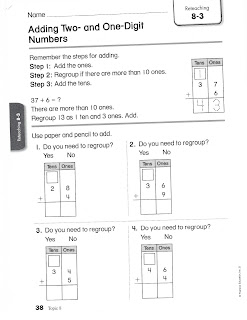No Homework!
Skate Night
The homework packet will be sent home tomorrow.
|
|
Spelling City Activity
|
Math
|
Reading - 15-20 minutes
USE TRC QUESTION STEMS FROM
BLOG
|
|
Monday
|
|
8-6 Page 240
Problem Solving
- solving
word problems with too much information
Rewrite addition problems
- we did
three in class and wrote equations for the remaining six problems
|
|
|
Tuesday
|
|
|
|
|
Wednesday
|
|
|
|
|
Thursday
|
|
|
MATH
Borrowing and
Regrouping
|
2. NBT.5 Fluently add and
subtract within 100 using strategies based on place value, properties of
operations, and/or the relationship between addition and subtraction.
2. NBT.B.6 Add up to four two-digit numbers using
strategies based on place value and properties of operations.
2.NBT.B.7 Add and subtract within 1000, using
concrete models or drawings and strategies based on place value, properties
of operations, and/or the relationship between addition and subtraction;
relate the strategy to a written method. Understand that in adding or
subtracting three-digit numbers, one adds or subtracts hundreds and hundreds,
tens and tens, ones and ones; and sometimes it is necessary to compose or
decompose tens or hundreds.
2. NBT.B.8 Mentally add 10 or 100 to a given number
100-900, and mentally subtract 10 or 100 from a given number 100-900.
2. NBT.B.9 Explain why addition and subtraction
strategies work, using place value and the properties of operations.
|
Practice and Enrichment
Earth Systems,
Structures and Processes
Essential Standard
and Clarifying Objectives
|
|||
2. E.1 Understand
patterns of weather and factors that affect weather.
|
|||
2.E.1.1
Summarize how energy
from the sun serves as a source of light that warms the land, air and water.
|
2.E.1.2
Summarize weather
conditions using qualitative and quantitative measures to describe:
• Temperature
• Wind direction
• Wind speed
• Precipitation
|
2.E.1.3
Compare weather
patterns that occur over time and relate observable patterns to time of day
and time of year.
|
2.E.1.4
Recognize the tools
that scientists use for observing, recording, and predicting weather changes
from day to day and during the seasons.
|
Students know that
light travels from the sun to the earth. Some of this light is reflected back
into space, some is absorbed by the land, water, and air.
|
Students know that
numbers are used to describe air temperature, wind speed, and the amount of
precipitation that occurs. Students know that wind direction is described
using cardinal directions (N, S, E, W) and numbers. Students know how to
measure air temperature with a thermometer,
wind direction with a wind sock or
vane, wind speed with an anemometer,
and precipitation with a rain gauge.
|
Students know that
over time there are patterns that can be observed in the weather and that
these patterns are influenced by the time of day (cooler morning, warmer
afternoon) and the time of year (seasonal changes).
|
Students are familiar
with manual and electronic weather instruments, sensors, and computers as
well as how they can produce a ‘running record’ of weather changes that occur
over time by collecting and recording data. This collection of data can be
analyzed as a basis for predicting weather trends.
|















No comments:
Post a Comment